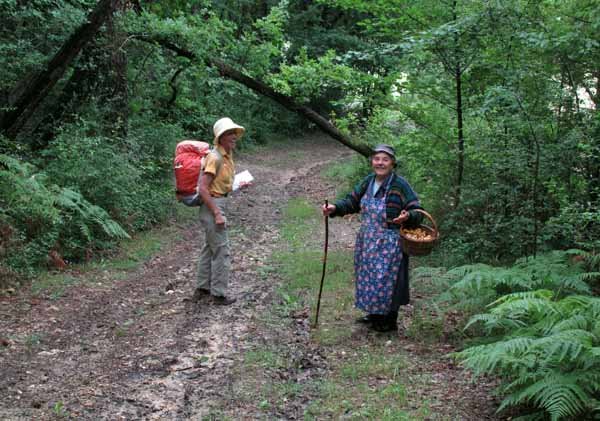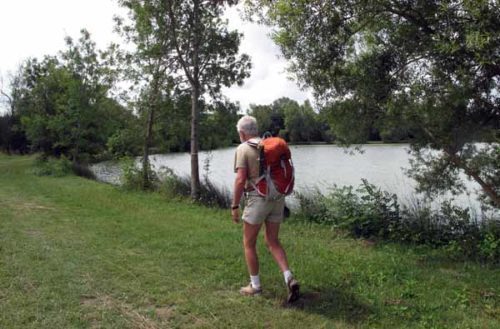Tuesday, 15 June 2010
Distance 25 km
Duration 5 hours 10 minutes
Ascent 317 m, descent 437 m
Map 56 of the TOP100 blue series (or Map 160 in the new lime-green series)
Topoguide (ref. 6542) Sentier vers Saint-Jacques-de-Compostelle via Vézelay

We were relieved to see that it was not actually raining in the morning, although the sky was a uniform white. After eating our muesli in the room, we collected our possessions and went downstairs for coffee.
Our host was serving a full breakfast to the other guest and no doubt thought us very hardy and strange.

Noticing some old photographs of the hotel on the wall, I asked him how old it was. He replied “Seng’ veng’ ong”, the heavy southern accent translated into standard French as “cent-vingt ans” (120 years).
Little of the hotel seems to have changed in that time – perhaps the plumbing.

Outside in the street, everything was rapidly vanishing in a white mist. Rather than taking the tortuous GR, we continued to the south end of town and turned onto the D413, a straight but empty road through prune plantations. We could see only the nearest trees because of the fog.
After half an hour the road did an odd little shuffle and proceeded under an arch that we recognised immediately as a railway overbridge. We had walked on several disused railway lines in France and we realised that this road was another one, with all the embankments, cuttings and bridges intact.
We stayed on it all the way to St-Pastour, ascending gradually to the rocky height on which the village sits.

Like Cancon, it was built in the thirteenth century, but has remained in its original form and has hardly spread beyond the encircling wall.
The blunt, uncompromising facade of the church frowned down as we approached. In a lane at its foot we found a tiny shop selling the bare necessities (such as croissants) and just along the way, to our considerable joy, was a bar.
A happy half-hour ensued in the comfort of the interior, looking out over what surely would have been a fine view, if we had been able to see it. Instead we were enclosed in a world of white.

Once our bloodstreams were satisfactorily charged with pastries and coffee, we strolled around the few streets of the village.
Apart from the school, everything looked as it must have in the beginning, when it was a new town, except for a certain surface decrepitude and the occasional parked car.

Descending to the main road again, we took the branch to Montclar (D152) and continued for a kilometre, ignoring the GR when it turned off on a muddy path.
The grey finger of the church of St-Pastour shrank and faded behind us.

Before long we branched off again on a nameless little road that looked shorter, but it was very steep and we were worried that the map showed it as a dead end. We just hoped that there would be a walking track after that to take us over the ridge.
There was indeed a track, deeply scored with the marks of tractor tyres and slimy with last autumn’s dead, blackened leaves.
The forest pressed in on both sides but it was a delightful walk and we felt pleased at having discovered it.

Having reached the top, we began to descend, when we met a little old woman emerging from the bushes.
She appeared from nowhere like a figure in a fairy tale, carrying on her arm a basket laden with mushrooms, which she showed us with some pride.
They were girolles and cèpes, she said, both very good eating. Her advice was to ignore the Private Property signs further down the track (“c’est un chemin communal”) and just keep going until we hit the road.

We did this, but the going was difficult, with heavy wet grass and a ditch full of water. We had to force our way between a barbed wire fence and a patch of thorny bushes before we could jump across. We were very glad when we finally arrived at the bitumen.
From there we set off on the road to Montclar and had the odd experience of meeting the GR coming the other way. We thought our way was much better, but we had not reckoned on the fact that it climbed to a great height near Montclar, while the GR kept to the valley. We later realised that we had missed a good short cut that avoided this climb.

As soon as we got to the first houses of Montclar, we turned downhill, away from the village, and promptly lost most of our hard-won altitude. Then the GR came in from the left and we stopped beside the road for a lunch of bread, cheese and salad. The wide valley was clothed in wheat, both above and below the road.
By this time we were tired of the bitumen, so we went with the GR when it turned off towards an artificial lake with a mill.

Past the lake we followed a stony white path that crossed the D667 and scrambled steeply up beside a wood, at the top of which was a descending slope planted with prunes and vines.
The GR signs took us along the edge of the wood, but then suddenly disappeared, presumably into thick shrubbery, and left us to our own devices.

One is never truly lost in France, and we made our way down the gentle slope on a zig-zag of tractor marks until we came to a road. It soon became clear that this was the road that we had recently turned off – we had made a very small amount of progress with a very large amount of effort.
At the first chance we turned right, passed the hamlet of Peyrebrune with its prune-drying barns made of dark, slatted wood, and pressed on until we came out on a proper road, that is to say a road with cars (the D225).
From here it was only a couple of kilometres into Castelmoron-sur-Lot, our destination, which was a sizeable village with a metal bridge like a coat hanger spanning a loop in the river.

The name does not refer to the intelligence of the inhabitants, but to the fact that the original castle, around which the village formed, was in a marshy place – it was a “castel des marais”.
At two o’clock in the afternoon it had an empty, slightly seedy look, but in the church square we found a café where lunches were being served in a garden. We went in for coffee.
The waitress said that they were not open in the evening but that there was another restaurant over the bridge a couple of kilometres.
This sounded good, as we already knew that the camping ground was immediately over the bridge on the river bank. She said that we should go to the Mairie to arrange to stay at the camping ground.

It was drizzling as we made our way around to the Mairie, but a momentary break in the clouds suffused the building with weak sunshine. Inside the grand entrance was a lobby with a long counter but no staff. We waited, coughed, talked loudly to each other, but nobody came. Then a large woman burst in from the street, in a hectic floral dress, with hair dyed scarlet and a personality to match.
She bounced up to us and asked what we wanted, although she did not really work there – she was some sort of liaison officer for the various tourist bureaux of the department. On hearing that we wanted to camp, she told us that the camping ground was closed and would not open until the first of July.
I pointed out that today was the 15th of June, when all camping grounds were supposed to be open, and she exclaimed, “But it’s still winter!”, pointing out the door at the wet grey street. She marched through a door behind the counter and returned with a bashful woman employee, who informed us that there was no hotel, no chambres, nowhere at all to stay in the town.

Our red-haired champion then had an idea – she would drive us to the neighbouring village, le Temple-sur-Lot, where she knew the camping ground was open, as it was run by a friend of hers. She herself was native of le Temple-sur-Lot, not from these parts, she confided (they were four kilometres apart).
We were not keen about having to walk back four kilometres in the morning to continue our walk, but she rang her friend at the camping ground and arranged for her to drive us back at 8 am.
Soon we were speeding along the rainy road in the first car that we had been in for almost a month, and as we swept into the village, we realised that we had been there before.

We recognised the magnificently restored fifteenth-century Commanderie of the Knights Templar, with its pools and fountains, and remembered that we had driven there with our friends from Montcuq in 2002, on our way to visit the famous water-lily nursery where Monet had bought his plants.
We had forgotten the name of the village but not its appearance. Both we and our benefactor were amazed at this.
At the camping ground, a round-faced, curly-haired woman in farm clothes emerged from a machinery shed and our exuberant friend introduced us before driving off.
Having paid our €7.30, we had hot showers and set up the tent while the sun shone. It did not shine for long, but we had time to rest on our mats on the dense, springy grass before the clouds closed in again.

The remainder of the afternoon was spent strolling into the centre of the village to investigate the possibilities for dinner. There was only one – the Commanderie, where there was a menu for €18.90. Nearby was a post office and a single shop, consisting of a small supermarket and a bar rolled into one. A glass of rosé and a look at the local paper whiled away a pleasant hour.
By the time we got back to the tent it was raining again and we had to retire to the interior. At 7:30 it was still raining, so we waited, only to find the rain getting heavier all the time.
In the end we crawled out, put on our flimsy plastic capes and hurried back to the Commanderie, where the fountains were playing relentlessly, despite the rain.

Inside we took off our streaming capes and hung them up, forming a pool on the stone floor. We were shown into a large baronial hall, already occupied by several groups of diners. Every table had a lamp which shed a romantic glow over the scene.
We began with salads – Keith had an anchovy and potato salad and I had the classic salade aux gésiers, best enjoyed without translation (if you must know, gésiers means gizzards).
For our main course, Keith had his unvarying steak, while I had an excellent duckling with cèpes, accompanied by braised fennel and shallots.

The last course gave Keith the opportunity to continue the field work for his forthcoming Ph.D. in Crème Brûlée Studies. I was full so I ordered cheese and put it away for tomorrow’s lunch.
The evening was fine as we emerged for the walk home. The scrubbed stonework of the Commanderie, lit by golden floodlights, was mirrored in the still water at its base, the fountains having been turned off for the night.
Nevertheless, we only got half way back to the tent before the rain started again.
Previous day: Castillonnès to Cancon